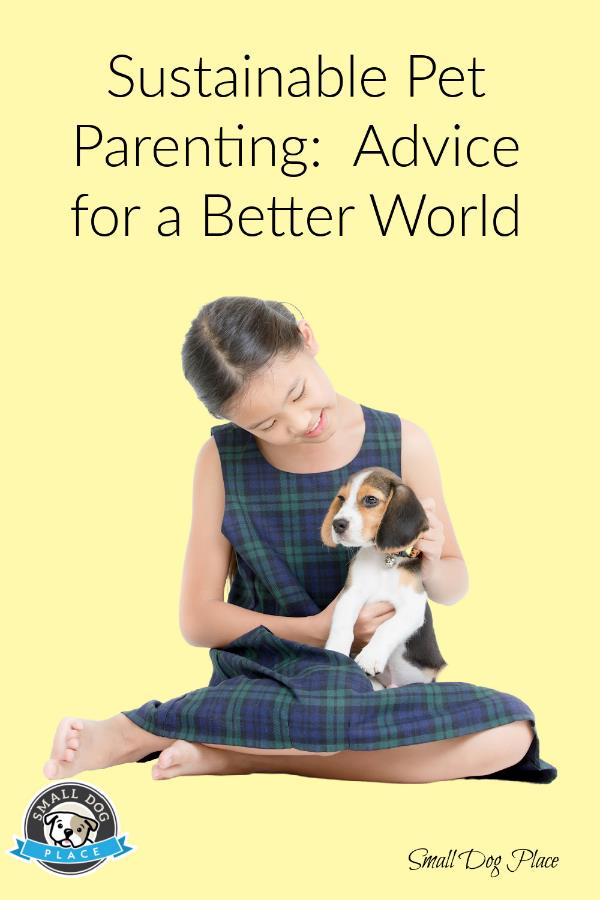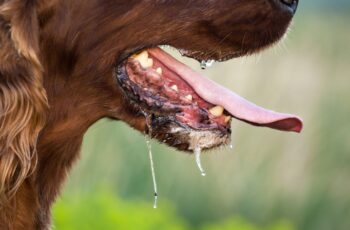Sustainable Pet Parenting by Cyd Ross |Published 11-04-2021
Reading Time: 7 min 29 sec
Being a pet parent can be a lot of work, but it can also be one of the most enjoyable parts of life, and your bond with your pet can be incredibly meaningful.
The challenges of pet parenting are numerous, however. One aspect that you may not immediately consider is how you and your pet’s lifestyle may affect our environment.
This applies even to small dogs. They may be little, but they can have an outsized impact on the local environment; several industries cater specifically to them, and that comes with an environmental footprint.
It’s not your dog’s fault, nor is it yours, but as a loving pet parent, you should do what you can to keep your dog happy and loved while also preserving the planet.
The need for a sustainability mindset has never been more apparent, as we’ve experienced dangerous shifts in the weather.
Incredible heat, floods, and other hazards over the recent decade have shown that we need to work toward promoting sustainable practices — and that also affects how we care for our pets. It is a lot to consider!
So, what can you do to become a sustainable pet parent?

Sustainable Pet Parenting: 5 Ways to Make Your Mark
One of your first steps to becoming a sustainable pet parent should focus on responsible pet ownership. Even small dogs have an impact on the environment.
When you factor in grooming, toys, and food, there is a lot of potential for outsized environmental waste. That can be tough to think about because we have so much love for our pets. However, the concern is also a sign that you are a responsible pet owner.
Sadly, not every person who takes in a small dog is prepared for the challenges of caring for them, let alone maintaining a sustainable lifestyle.
If you are the type of person who prioritizes sustainability when it comes to pet parenting, you are also the right choice to help little dogs find their forever homes.
Adopting a dog is one of the easiest ways to promote sustainability. There are millions of animals seeking homes. Adopting pets reduces demand for breeders and puppy mills.
And don’t forget to do your part in maintaining a healthy population by spaying and neutering your pet. Spaying and neutering are essential for the environment because they can reduce the number of pets that may find their way into shelters.
They even have added health benefits for your dog, such as reducing their risks of contracting certain diseases and cancers. Thankfully, caring for your pet in this way does not need to break the bank. You can check out the ASPCA’s guide to low-cost spay and neuter programs to work within your budget.
Grooming
Another step toward becoming a sustainable pet parent is rethinking how you groom your dog. There can be many challenges when it comes to ecologically sustainable care and grooming for your small dog. For example, helping your dog maintain a clean and shiny coat requires the right pet care products — and finding such products that are not harmful to the environment limits your choices.
Sadly, many household detergents and soaps can do damage to the environment. The Environmental Protection Agency explicitly advises that you should use phosphate-free soaps. That applies to you and your four-legged friend.
Luckily, there are options. There are specialized companies that make grooming products for dogs that contain wholesome ingredients like botanicals rather than harmful chemicals.
Such ingredients do the same work as less-ecologically friendly options and have the added benefit of giving you peace of mind about your dog’s health.
You can keep your small dog looking fabulous while remaining confident that you are doing your part to help the environment. Such products may even help with sensitive skin and other concerns.
Remember, though not all dogs have the same grooming needs, so do your research and know the particulars about your companion’s breed.
Grooming can involve many steps, so it’s important to make sure you understand the full process and how to adopt sustainable methods.
Dog Waste
Sustainable pet parenting isn’t very glamorous at times. Dog owners know that dogs can make quite the mess, even little ones.
Pet waste is something most of us would rather not think about too often, but it is worth factoring it into your sustainability lifestyle. One group that gets paid to consider these things, the EPA, has a lot to say on dog doo.
Specifically, the EPA notes that animal waste contains pollutants that can contaminate water. Waste that finds its way into the water supply can release nutrients that cause algae blooms that can harm the homeostasis of the water.
People and animals can get very sick from this. Additionally, dog waste should generally not be composted either because the parasites, viruses, and bacteria present in dog waste do not break down appropriately with composting.
If you are still interested in composting, it is possible, but you need to contain it in a completely separate bin to avoid cross-contamination.
To handle the daily dog business sustainably, you can purchase biodegradable doggie poop bags — just make sure they are truly biodegradable. Sadly, some companies mislead consumers about whether their products are biodegradable.

Toys
Another part of being a sustainable pet parent is sourcing their toys in the most environmentally friendly way possible. Dogs, like humans, need stimulation, and one of the best ways to provide that stimulation is through lots of toys.
However, many dog toys, at least traditionally, are made from chemicals and plastics that are harmful to the environment. So one strategy is to reuse as many toys as possible.
You also should try to limit the number of plastic toys you purchase, as they can contain chemicals that are toxic and do not biodegrade easily. You can also consider repurposing old items in the home that can be turned into pet-safe toys.
For example, old t-shirts and towels can be cut into strips and woven together into ropes and other chew toys.
If your little dog is more rough-and-tumble, then these homemade ropes might prove longer-lasting and more satisfying than any you buy online or at pet megachains.
Combining these homemade toys with fun activities, indoors and out, can make lasting memories with your best friend and keep them happy and motivated.
Food
One of the most challenging and essential parts of pet parenting is rethinking how you feed your dog. The production of food for us and our four-legged friends is a significant contributor to environmental damage.
The primarily meat-based diets of most dogs can take their toll on resources. Roughly a quarter of the meat proteins produced in the United States goes toward pet food. One 2007 study found that the carbon print of pet food was 64 million tons of carbon dioxide in the US alone. Food is a necessity, though, so what can be done?
Shopping for sustainable dog food is one way to lessen the strain on the environment while also ensuring your dog gets the nutrients they need. The key component for your dog’s diet is protein, so whatever option you take when it comes to sustainable dog food, you need to make sure your dog gets the nutrients they need.
Another option, however, would be making your own food for your small dog. Smaller dogs have certain dietary concerns, and you can create food that not only meets these concerns but also lessens your impact on the environment.
Best of all, making food for your dog shows your love for them and your commitment to doing the most good you can for them, yourself, and the world.
Reducing the Carbon Paw-Print
When it comes to being a sustainable pet parent, grooming, feeding, and playing are all essential parts of bonding with your pet. Unfortunately, these essential parts of a dog’s life can also be areas where we don’t realize the environmental impact. We may too often turn to industry to fill these needs and not take into account the amount of harm they can cause.
There are many ways you and your little dog can live your best life without taxing the planet more than you have to, and we hope that you’ve picked up on a couple of valuable tips. There is a lot to factor in, even with the smallest dogs, but you have plenty of options available.
All you need is a lot of love for your dog and the planet.
Sustainable Pet Parenting: Pin for Future Reference

Author bio: Sustainable Pet Parenting
 Cyd Ross
Cyd RossCyd Ross is a founding member of an organization dedicated to rescuing livestock and pets from evacuation zones. Ranch life has given her experience with most animals, but her focus is on training horses and dogs. Cyd loves competing in endurance events of 50-100 miles with her Arabians.
Does This Article Deserve Your Thumbs Up?
We always appreciate your support and encouragement. Your thumbs up means so much to us. Please like this article.
If you find this page or any page on Small Dog Place Helpful, or Useful in anyway, I’d love it if you would click the small heart found on the bottom right of each page.
You can also share or bookmark this page — just click on the:

Free Monthly Newsletter
Sign Up for Our Free Newsletter and get our Free Gift to You.
my E-book, The Top 10 Mistakes People Make When Choosing a Dog (and how to avoid them)


